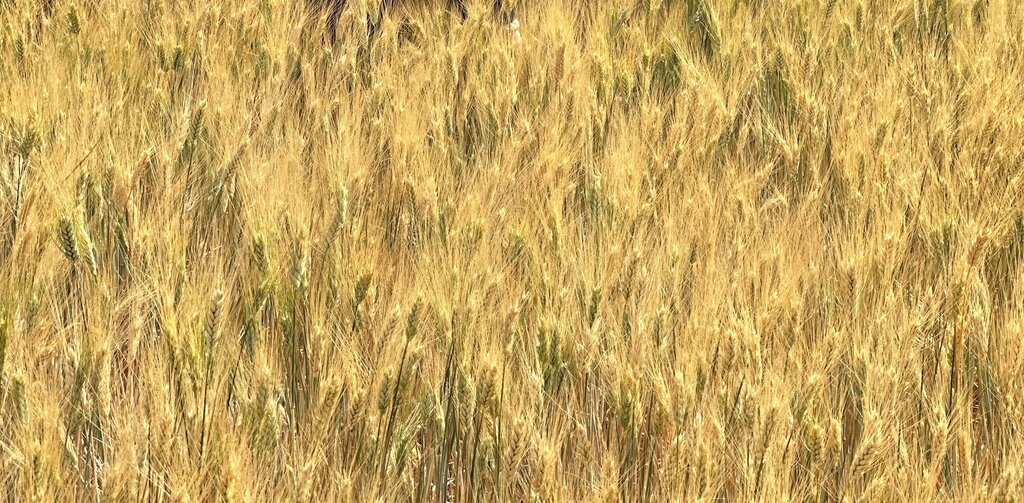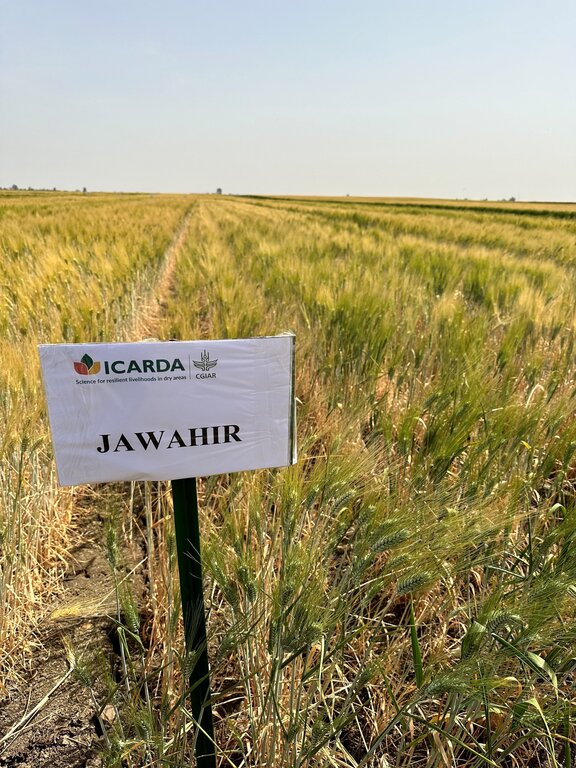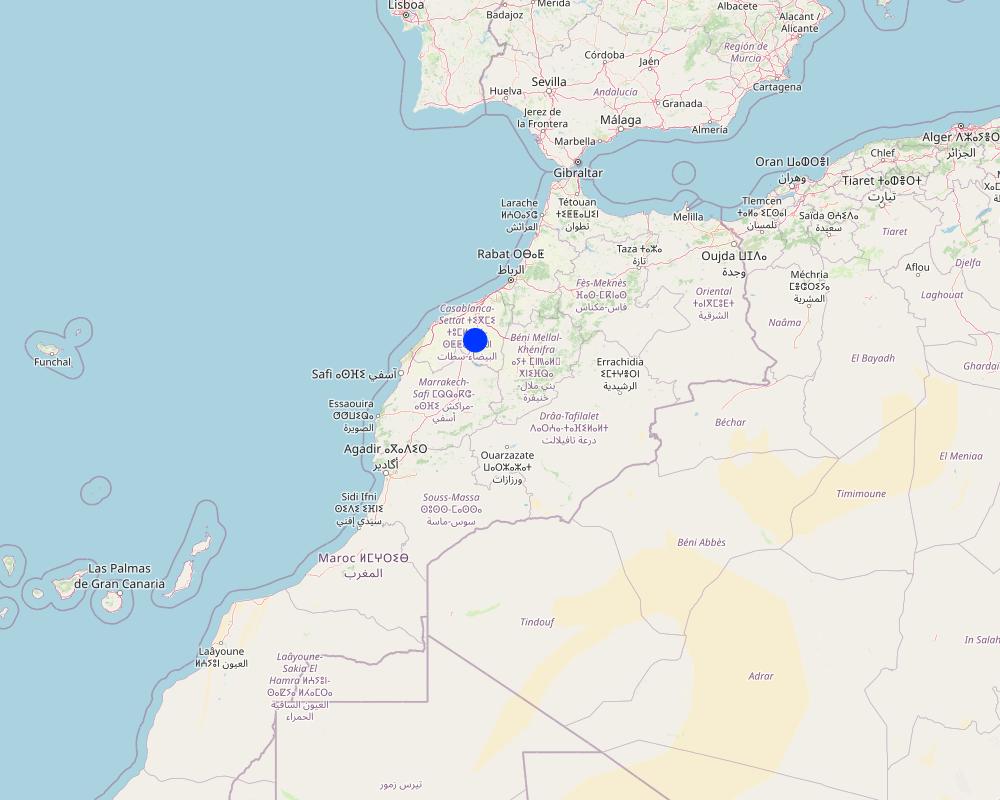Drought tolerant durum wheat variety: Jawahir [Morocco]
- Creation:
- Update:
- Compiler: Joren Verbist
- Editor: –
- Reviewers: William Critchley, Rima Mekdaschi Studer
technologies_6804 - Morocco
View sections
Expand all Collapse all1. General information
1.2 Contact details of resource persons and institutions involved in the assessment and documentation of the Technology
Key resource person(s)
Principal Investigator Genetic Innovation:
Bassi Filippo
International Center of Agriculture Research in the Dry Areas (ICARDA)
Morocco
Research Assistant, Entomology:
Boulamtat Rachid
International Center of Agriculture Research in the Dry Areas (ICARDA)
Morocco
Breeding Lead:
Ferrahi Moha
Institut National de la Recherche Agronomique (INRA)
Morocco
Name of project which facilitated the documentation/ evaluation of the Technology (if relevant)
ICARDA Institutional Knowledge Management InitiativeName of the institution(s) which facilitated the documentation/ evaluation of the Technology (if relevant)
International Center for Agricultural Research in the Dry Areas (ICARDA) - Lebanon1.3 Conditions regarding the use of data documented through WOCAT
The compiler and key resource person(s) accept the conditions regarding the use of data documented through WOCAT:
Ja
1.4 Declaration on sustainability of the described Technology
Is the Technology described here problematic with regard to land degradation, so that it cannot be declared a sustainable land management technology?
Nee
2. Description of the SLM Technology
2.1 Short description of the Technology
Definition of the Technology:
Jawahir, an improved durum wheat variety, serves as a resilient solution to the challenges of climate change in dry areas by offering disease and pest resistance, drought tolerance, higher grain and straw yields, as well as cost savings, thereby enhancing farmers' income and sustainability.
2.2 Detailed description of the Technology
Description:
Climate change exacerbates the difficulties faced by farmers in dry areas by amplifying drought conditions. Limited water availability and higher temperatures disrupt crop growth and heighten the vulnerability of plants to pests such as the Hessian fly (Mayetiola destructor). This leads to increased risks of crop damage, reduced yields, and economic losses in these regions.
Genetically improving crop varieties can help overcome these issues by making crops more resilient. An international collaboration led by the International Center of Agricultural Research in Dry Areas (ICARDA-Morocco) has delivered six ground-breaking new durum wheat and barley varieties tolerant to increasingly severe droughts ravaging the region. Improvement is performed through Molecular Breeding which consists of markers to select specific traits and conventional phenotypic.
This case study revolves around an improved durum wheat variety named Jawahir. The main advantages of this variety are:
•Cost savings: Jawahir's suitability for zero tillage helps to eliminate the need for ploughing, reducing the associated costs for farmers.
•Disease and pest resistance: Jawahir's resistance to diseases and pests, including the Hessian fly, minimizes the expenses related to fungicides and insecticides.
•Higher grain yield: Compared to competing varieties (like Karim and Kanakis), Jawahir can yield an additional 700 kilograms per hectare under dry conditions, increasing farmers' productivity and potential income.
•Enhanced straw yield: Jawahir also produces an additional 500 kilograms of straw compared to competing varieties during drought, providing additional feed for fodder and for mulching under conservation agriculture systems.
Jawahir was introduced in the Settat-Safi region (Morocco) where annual precipitation is between 300 and 400 mm. While cultivation practices may vary, it is recommended to include Jawahir in a conservation agriculture (zero/ minimum till) system. Crop management includes machine seeding in November at a rate of 200 kg per hectare corresponding to approximately 300 plants per square meter. Fertilizer application consists of manually applying 200 kg of NPK (15:20:15) in November and 100 kg of urea in February. Herbicide application of 1 litre is suggested in February. Harvesting takes place in June using a combine harvester, and during July and August, the stubble is left for grazing. Following this crop management system, the costs per hectare are estimated to be around 2610 Moroccan Dirham (about 261 USD) per hectare.
The direct gross income from Jawahir, based on grain yield, is approximately 1,120 USD per hectare, based on a yield of 3,200 kilograms and a selling price of 35 USD per 100 kilograms. The additional gross income from straw yield is around 1,100 USD per hectare, assuming a yield of 5,500 kilograms and a price of 20 USD per 100 kilograms. This results in a total direct gross income of 2,220 USD per hectare.
However, if processed into couscous for human consumption, Jawahir's higher semolina yield (i.e. more kilograms of semolina per kilogram of grain milled) and better semolina color means an extra gross income of 4,560 USD per hectare. Additionally, when the straw is used for animal fattening, the extra output per hectare is around 900 kilograms of lamb meat (based on a conversion rate of 6 kilograms of feed to 1 kilogram of meat). Then the total extra gross income from production of meat is 5,500 USD per hectare.
Including both direct and indirect income, Jawahir provides a total gross income of approximately 12,280 USD per hectare from grain, straw, couscous, and animal fattening.
In conclusion, enhanced crop varieties like Jawahir offer increased resilience to the challenges posed by climate change in dry areas. These varieties provide benefits such as cost savings, disease and pest resistance, and improved yields. By adopting these varieties, farmers can enhance their agricultural productivity and mitigate the impacts of climate change on their livelihoods.
Acknowledgement: ICARDA’s work on breeding is supported by the Accelerated Breeding Initiative of the CGIAR and The Crop Trust. The variety release was through INRA Morocco.
2.3 Photos of the Technology
2.5 Country/ region/ locations where the Technology has been applied and which are covered by this assessment
Country:
Morocco
Region/ State/ Province:
Settat-Safi
Specify the spread of the Technology:
- evenly spread over an area
If precise area is not known, indicate approximate area covered:
- 0.1-1 km2
Is/are the technology site(s) located in a permanently protected area?
Nee
Map
×2.6 Date of implementation
Indicate year of implementation:
2022
2.7 Introduction of the Technology
Specify how the Technology was introduced:
- during experiments/ research
- through projects/ external interventions
3. Classification of the SLM Technology
3.1 Main purpose(s) of the Technology
- improve production
- reduce risk of disasters
- adapt to climate change/ extremes and its impacts
- create beneficial economic impact
- create beneficial social impact
3.2 Current land use type(s) where the Technology is applied
Land use mixed within the same land unit:
Nee

Cropland
- Annual cropping
- Durum what: Jawahir
Number of growing seasons per year:
- 2
Is intercropping practiced?
Nee
Is crop rotation practiced?
Ja
If yes, specify:
Jawahir can be included in crop rotations, especially well fitted with Conservation Agriculture. This could include legumes (e.g., vetch or faba bean) as well.
3.3 Has land use changed due to the implementation of the Technology?
Has land use changed due to the implementation of the Technology?
- No (Continue with question 3.4)
3.4 Water supply
Water supply for the land on which the Technology is applied:
- rainfed
3.5 SLM group to which the Technology belongs
- improved plant varieties/ animal breeds
3.6 SLM measures comprising the Technology

agronomic measures
- A5: Seed management, improved varieties
3.7 Main types of land degradation addressed by the Technology

chemical soil deterioration
- Cn: fertility decline and reduced organic matter content (not caused by erosion)

biological degradation
- Bp: increase of pests/ diseases, loss of predators
3.8 Prevention, reduction, or restoration of land degradation
Specify the goal of the Technology with regard to land degradation:
- reduce land degradation
- adapt to land degradation
4. Technical specifications, implementation activities, inputs, and costs
4.1 Technical drawing of the Technology
Technical specifications (related to technical drawing):
The recommended plant density is around 300 plants per square meter.
4.2 General information regarding the calculation of inputs and costs
Specify how costs and inputs were calculated:
- per Technology area
Indicate size and area unit:
1 Hectare
other/ national currency (specify):
Morrocan Dirham
If relevant, indicate exchange rate from USD to local currency (e.g. 1 USD = 79.9 Brazilian Real): 1 USD =:
10.0
Indicate average wage cost of hired labour per day:
80
4.5 Maintenance/ recurrent activities
| Activity | Timing/ frequency | |
|---|---|---|
| 1. | Seeding | November |
| 2. | First fertilizer application (NPK) | November |
| 3. | Second fertilizer application (Urea) | Ferbruary |
| 4. | Herbicide application | February |
| 5. | Harvesting | June |
| 6. | Stubble left for grazing | June - August |
4.6 Costs and inputs needed for maintenance/ recurrent activities (per year)
| Specify input | Unit | Quantity | Costs per Unit | Total costs per input | % of costs borne by land users | |
|---|---|---|---|---|---|---|
| Labour | Seeding | Person-day | 2.0 | 80.0 | 160.0 | |
| Labour | Fertilizer application | Person-day | 4.0 | 80.0 | 320.0 | |
| Labour | Herbicide application | Person-day | 2.0 | 80.0 | 160.0 | |
| Labour | Harvesting | Person-day | 2.0 | 80.0 | 160.0 | |
| Equipment | Seeder | Machine-hour | 2.0 | 100.0 | 200.0 | |
| Equipment | Combine | Machine-hour | 2.0 | 200.0 | 400.0 | |
| Plant material | Jawahir seed | 100 Kilogram | 2.0 | 130.0 | 260.0 | |
| Fertilizers and biocides | First fertilizer: NPK (15:20:15) | 100 Kilogram | 2.0 | 250.0 | 500.0 | |
| Fertilizers and biocides | Second fertilizer: Urea | 100 Kilogram | 1.0 | 200.0 | 200.0 | |
| Fertilizers and biocides | Herbicide | Liter | 1.0 | 250.0 | 250.0 | |
| Total costs for maintenance of the Technology | 2610.0 | |||||
| Total costs for maintenance of the Technology in USD | 261.0 | |||||
5. Natural and human environment
5.1 Climate
Annual rainfall
- < 250 mm
- 251-500 mm
- 501-750 mm
- 751-1,000 mm
- 1,001-1,500 mm
- 1,501-2,000 mm
- 2,001-3,000 mm
- 3,001-4,000 mm
- > 4,000 mm
Agro-climatic zone
- semi-arid
- arid
5.2 Topography
Slopes on average:
- flat (0-2%)
- gentle (3-5%)
- moderate (6-10%)
- rolling (11-15%)
- hilly (16-30%)
- steep (31-60%)
- very steep (>60%)
Landforms:
- plateau/plains
- ridges
- mountain slopes
- hill slopes
- footslopes
- valley floors
Altitudinal zone:
- 0-100 m a.s.l.
- 101-500 m a.s.l.
- 501-1,000 m a.s.l.
- 1,001-1,500 m a.s.l.
- 1,501-2,000 m a.s.l.
- 2,001-2,500 m a.s.l.
- 2,501-3,000 m a.s.l.
- 3,001-4,000 m a.s.l.
- > 4,000 m a.s.l.
Indicate if the Technology is specifically applied in:
- not relevant
5.3 Soils
Soil depth on average:
- very shallow (0-20 cm)
- shallow (21-50 cm)
- moderately deep (51-80 cm)
- deep (81-120 cm)
- very deep (> 120 cm)
Soil texture (topsoil):
- medium (loamy, silty)
Soil texture (> 20 cm below surface):
- medium (loamy, silty)
Topsoil organic matter:
- low (<1%)
5.4 Water availability and quality
Ground water table:
5-50 m
Availability of surface water:
poor/ none
Water quality (untreated):
poor drinking water (treatment required)
Water quality refers to:
ground water
Is water salinity a problem?
Ja
Is flooding of the area occurring?
Nee
5.5 Biodiversity
Species diversity:
- low
Habitat diversity:
- low
5.6 Characteristics of land users applying the Technology
Sedentary or nomadic:
- Sedentary
Market orientation of production system:
- mixed (subsistence/ commercial)
Off-farm income:
- less than 10% of all income
Relative level of wealth:
- poor
Individuals or groups:
- individual/ household
Level of mechanization:
- mechanized/ motorized
Gender:
- women
- men
Age of land users:
- middle-aged
5.7 Average area of land used by land users applying the Technology
- < 0.5 ha
- 0.5-1 ha
- 1-2 ha
- 2-5 ha
- 5-15 ha
- 15-50 ha
- 50-100 ha
- 100-500 ha
- 500-1,000 ha
- 1,000-10,000 ha
- > 10,000 ha
Is this considered small-, medium- or large-scale (referring to local context)?
- small-scale
- medium-scale
5.8 Land ownership, land use rights, and water use rights
Land ownership:
- individual, not titled
- individual, titled
Land use rights:
- individual
Water use rights:
- individual
Are land use rights based on a traditional legal system?
Ja
5.9 Access to services and infrastructure
health:
- poor
- moderate
- good
education:
- poor
- moderate
- good
technical assistance:
- poor
- moderate
- good
employment (e.g. off-farm):
- poor
- moderate
- good
markets:
- poor
- moderate
- good
energy:
- poor
- moderate
- good
roads and transport:
- poor
- moderate
- good
drinking water and sanitation:
- poor
- moderate
- good
financial services:
- poor
- moderate
- good
6. Impacts and concluding statements
6.1 On-site impacts the Technology has shown
Socio-economic impacts
Production
crop production
fodder production
risk of production failure
Income and costs
expenses on agricultural inputs
Comments/ specify:
When used in Conservation Agriculture
farm income
workload
Comments/ specify:
When used in Conservation Agriculture
Socio-cultural impacts
food security/ self-sufficiency
Ecological impacts
Climate and disaster risk reduction
drought impacts
Specify assessment of on-site impacts (measurements):
Data was retrieved from field trials and expert (also farmer) estimation.
6.2 Off-site impacts the Technology has shown
Specify assessment of off-site impacts (measurements):
Not applicable/relevant
6.3 Exposure and sensitivity of the Technology to gradual climate change and climate-related extremes/ disasters (as perceived by land users)
Gradual climate change
Gradual climate change
| Season | increase or decrease | How does the Technology cope with it? | |
|---|---|---|---|
| annual temperature | increase | very well |
Climate-related extremes (disasters)
Climatological disasters
| How does the Technology cope with it? | |
|---|---|
| heatwave | well |
| drought | well |
Biological disasters
| How does the Technology cope with it? | |
|---|---|
| insect/ worm infestation | well |
Comments:
Very well again Hesian fly
6.4 Cost-benefit analysis
How do the benefits compare with the establishment costs (from land users’ perspective)?
Short-term returns:
very positive
Long-term returns:
very positive
How do the benefits compare with the maintenance/ recurrent costs (from land users' perspective)?
Short-term returns:
very positive
Long-term returns:
very positive
6.5 Adoption of the Technology
- 1-10%
If available, quantify (no. of households and/ or area covered):
4 farms have adopted for seed production
Of all those who have adopted the Technology, how many did so spontaneously, i.e. without receiving any material incentives/ payments?
- 0-10%
Comments:
Four farms do not receive subsidies, but do receive technical support.
6.6 Adaptation
Has the Technology been modified recently to adapt to changing conditions?
Nee
6.7 Strengths/ advantages/ opportunities of the Technology
| Strengths/ advantages/ opportunities in the land user’s view |
|---|
| Drought tolerant |
| Resistant to pests and diseases |
| Higher yield than other varieties |
| Strengths/ advantages/ opportunities in the compiler’s or other key resource person’s view |
|---|
| Although it is recommended to cultivate within Conservation Agriculture, it can be easily incorporated in conventional systems |
6.8 Weaknesses/ disadvantages/ risks of the Technology and ways of overcoming them
| Weaknesses/ disadvantages/ risks in the land user’s view | How can they be overcome? |
|---|---|
| Primary risk is the potential failure of seed production in the early stages. | To support the production process to the fullest extent possible. |
| Weaknesses/ disadvantages/ risks in the compiler’s or other key resource person’s view | How can they be overcome? |
|---|---|
| Primary risk is the potential failure of seed production in the early stages, which could prevent Jawahir from reaching its full market potential. | To support the production process to the fullest extent possible. |
7. References and links
7.1 Methods/ sources of information
- field visits, field surveys
- interviews with SLM specialists/ experts
- compilation from reports and other existing documentation
When were the data compiled (in the field)?
2022
7.3 Links to relevant online information
Title/ description:
Filippo Bassi, Hajar Brahmi, Abdelhadi Sabraoui, Ahmed Amri, Nasserlehaq Nsarellah, Nachit Miloudi, Ayed Al-Abdallat, Ming-Shun Chen, Abderrahim Lazraq, Mustapha El Bouhssini. (8/2/2019). Genetic identification of loci for Hessian fly resistance in durum wheat. Molecular Breeding, 39 (2).
URL:
https://hdl.handle.net/20.500.11766/10902
Title/ description:
Noureddine El Haddad, Miguel Sanchez-Garcia, Andrea Visioni, Jilal Abderrazek, Rola El Amil, Amadou T. Sall, Wasihun Lagesse, Shiv Kumar Agrawal, Filippo Bassi. (11/11/2021). Crop Wild Relatives Crosses: Multi-Location Assessment in Durum Wheat, Barley, and Lentil. Agronomy, 11 (11).
URL:
https://hdl.handle.net/20.500.11766/66379
Title/ description:
Noureddine El Haddad, Hafssa Kabbaj, Meryem Zaim, Khaoula El Hassouni, Amadou T. Sall, Mounira Azouz, Rodomiro Ortiz, Michael Baum, Ahmed Amri, Fernanda M. Gamba, Filippo Bassi. (1/2/2021). Crop wild relatives use in durum wheat breeding: drift or thrift. Crop Science, 61 (1), pp. 37-54.
URL:
https://hdl.handle.net/20.500.11766/11254
Links and modules
Expand all Collapse allLinks
No links
Modules
No modules






